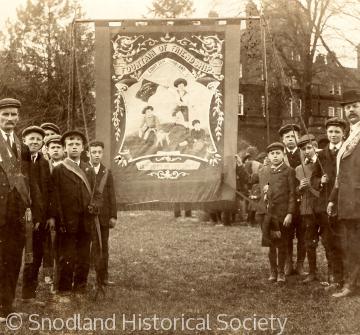Clubs and Societies
 The Snodland Fountain of Friendship banner. The Fountain of Friendship was a lodge of the Ancient Order of Foresters, a Friendly Society offering sup
The Snodland Fountain of Friendship banner. The Fountain of Friendship was a lodge of the Ancient Order of Foresters, a Friendly Society offering supSome of the earliest societies were the medieval fraternities and gilds connected with the parish church. They provided practical and spiritual benefits for their members. The idea was revived in the 18th century in the form of the friendly society whose members paid subscriptions, which covered sickness benefits and funerals. Apart from the national societies there were local friendly and tradesmen's societies in most areas. Other self help societies, often found in industrial areas, were co-operative societies, temperance societies, mechanics' institutes, night and adult Sunday schools and reading rooms. The 19th and early 20th century also the development of the trade union, which although designed to improve working conditions and pay, also supported its members in times of hardship and some provided educational opportunities. Most organisations were for men although there were female friendly societies and later Women's Institutes and Townswomen's Guilds.
It was not only the working classes who formed groups for common interest. Educated people began from the 17th century to form learned societies to further scientific and artistic endeavour and also to socialise. The Royal Society is the best known but many others were formed especially in the 18th and 19th centuries including county archaeological and historical societies, often with museums and libraries, local harmonic societies and glee clubs. Once again they were mainly for men although county societies often took women members to support their social activities.
The upper classes subscribed to hunting groups but others took an interest in sports such as cricket and golf and formed clubs. By the late 19th century football and rugby were popular and many clubs were formed even in villages. Tennis, archery and croquet clubs were very popular with women. By the mid 20th century most communities had a wide variety of recreational and charitable societies.








